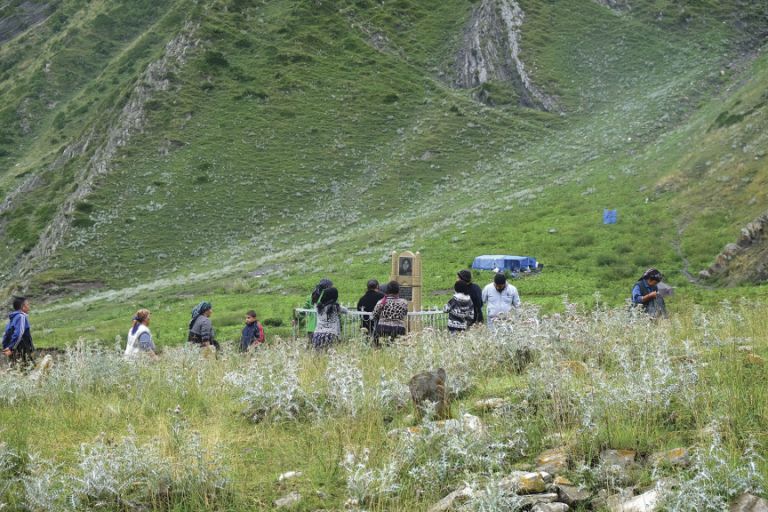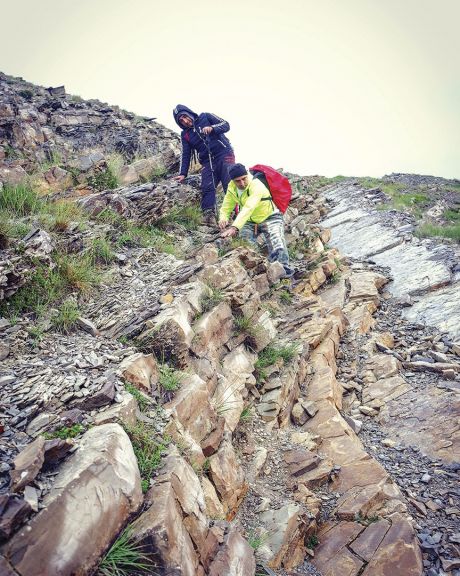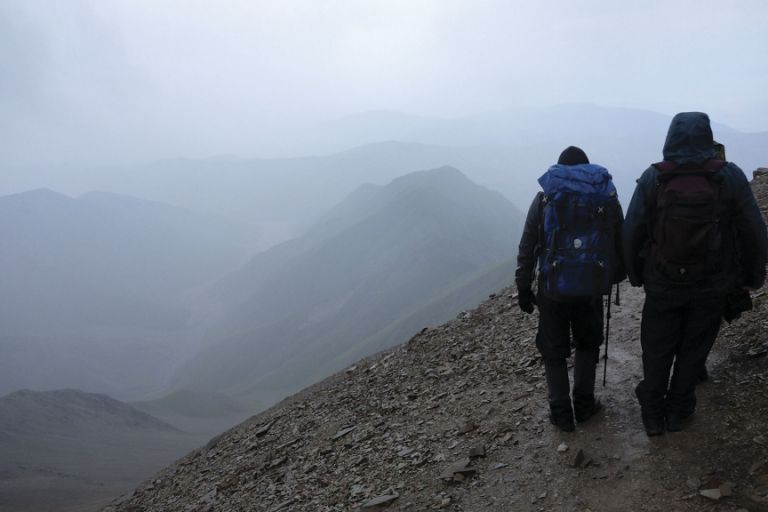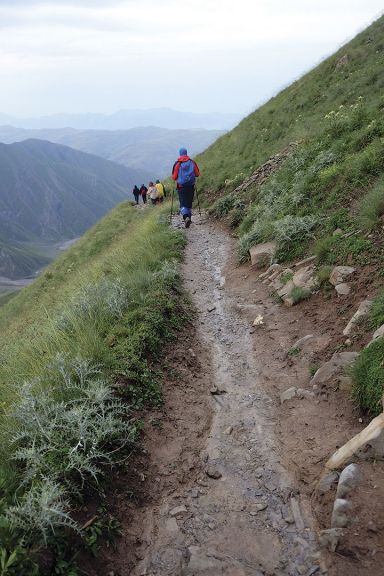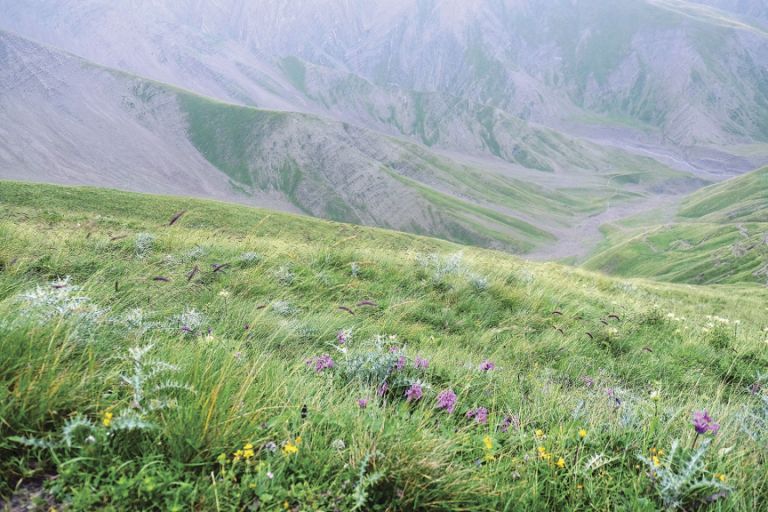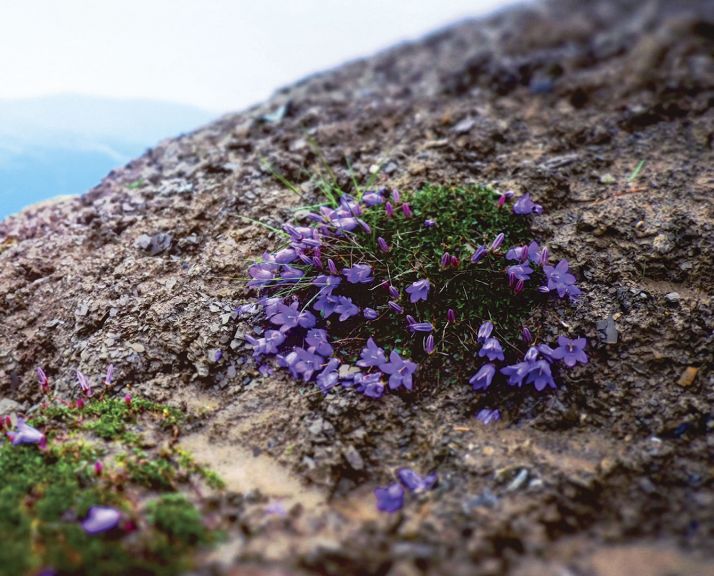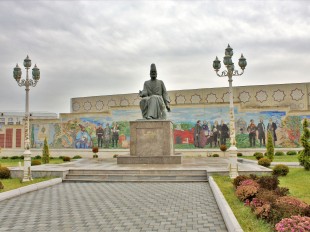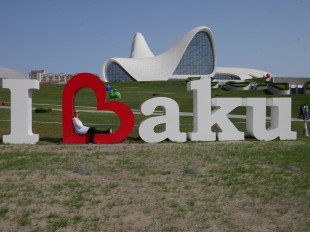With over half of its land covered by mountains, Azerbaijan caters for outdoor activity enthusiasts with ideal venues for hiking, camping, mountaineering and rock climbing. Shortly after my first hike in the village of Laza in the Qusar region, I decided to take a remarkable leap by challenging the 3,629m high Mount Babadag, one of the highest mountains in Azerbaijan, with a stunning panorama on its bald peak.
The group I was with is a newly established community named Vertical Azerbaijan. The group leader Nurlan Khudazarov, an avid practioner of extreme sports, aims to bring people with the same interests together. So far, the group has conquered the world famous Mount Elbrus, Mount Kazbeki, which is the third highest peak in Georgia, Mount Savalan in northwestern Iran and Mount Damavand, the highest peak in Iran, as well as local mountains such as Khinalig, Khizi, Nial and Fit. Names on their to-do list include Shahdagh, Khizi and others. According to Nurlan, Babadag covers certain cliffy sections and was going to be quite difficult for me, yet it was worth the effort to try.
A sacred mountain
Apart from its height (3,628m), Mount Babadag, which straddles the Ismayilli and Quba regions, is well known for its holiness. Baba indicates respect and Babadag (literally ‘Grandfather Mountain’) carries the meaning of a high mountain covered with snow. As a matter of fact, there are many holy mountains in other parts of the world that bear the same name.
Besides, the mountain also has several other names. Some people call it Qarli baba (Snowy Grandfather) because its peak is snow-covered throughout the year. Others address it as Hazrati Baba Ziyaretgahi (‘Grandfather’s Pilgrimage’), believing that those who visit this place seven times receive the honorific title of Hazrat, meaning ‘His Holiness’ or ‘Your Majesty.’
At the foot of Babadag, a line of buses and trucks may be noticed whose inhabitants distinguish themselves with their fancy-coloured outfits. They are pilgrims from other regions of Azerbaijan. Each year, particularly during summer months, numerous pilgrims, most of them religious, pay homage to Babadag because of its magical power to turn people’s wishes into reality. Merely two roads lead to Babadag – one from Ismayilli and another from Quba. The pilgrimage path starts from a place called Gurbangah. At the campsite there you may also see a large iron unit with a moon and star on top. Ribbons of various colours are tied to it. Nearby are tombs where people pray and mourn for the dead.
Magical places are always abundant with beautiful legends, and so is Babadag. According to one legend, a shepherd named Hazrat Baba was one of God’s favourite servants. He loved his mother-in-law deeply. While shepherding, he once stepped on a grain of wheat in the cornfield. Being sad about it, he went to the mountain with his mother-in-law to beg forgiveness from God. His mother-in-law stayed at the foot of the mountain while Hazrat climbed to the top. It is said that he then disappeared from the material world.
Another legend says Hazrat Baba lived in Saudi Arabia but after Islam had spread there, he came to present day Azerbaijan. At an event he stepped on some rice and that night he had a dream: God summoned him to Mount Babadag in order to wash away his sin and showed him the way. The next morning, Hazrat and his family started out. It is said that his mother refused to climb the mountain, while his sister Agabike didn’t want to leave her brother, so both of them stayed at the top of Babadag.
In another version, Hazrat Baba stepped on the rice and set out to the mountains. His mother and three sisters filled some plates with rice (plov) and went to find him. He told them not to approach as he had committed a sin. But they didn’t listen and asked him to eat from the plates. Tragically, all of them were turned into stones. Some say that their figures, even the plates, are still visible in those stones today.
Arrival at the campsite
Following a brief tour at Lahij, a village situated in the Ismayilli region of Azerbaijan, which is famous for its handicrafts, particularly copper-making, we set out for the seasonal campsite Gurbangah. The bus became a jeep as we marched towards the holy mountain along bumpy roads. In total twelve hikers, ten guys and us two girls, were stuffed into the cramped jeep along with the space-consuming camping and mountaineering equipment.
It was a late July afternoon, yet the hilarious music plus endless jokes were sufficient to kill the dreary atmosphere. The views outside the windows remained more or less the same with soily slopes and yellow heaps of straw. Occasionally, there was a glimpse of herds of sheep, chewing or strolling leisurely, accompanied by a vigorous sheep dog. The relatively flat road was followed by a rugged one that lasted for over an hour. It was a riverbed, to be specific, which had been drained under the scorching summer sun. In certain places where water was still flowing, the jeep sped across.
After two hours of jolting and bumping, we finally arrived at the campsite. It was a valley embraced by green mountains equipped with basic facilities. We climbed to an upper platform and started to construct our base. Pitching a few tents was nothing difficult for our professional team. In no time, we settled down and began to collect stones and firewood to make a campfire. A hilarious party was about to unfold before we were disappointingly informed that fire was banned in the nature reserve. So the bonfire party was replaced by a picnic dinner instead.
Go for the peak
In order to watch the sunrise at dawn, we rescheduled by bringing forward our plan to begin the ascent by five hours. That was equal to saying: we merely had two hours rest before setting out. The guys were probably too excited to sleep and kept on messing about, but I fell sound asleep to their laughter.
At 11pm, the other girl, Camelia Alizade, woke me up punctually. I remained sluggish for a short while before my mind refreshed suddenly when I realised where I was and what I was going to do. Within half an hour, everyone had packed up and was ready to go. I was both excited and tense because this was my first expedition.
The initial paths were even. However, without a headlight or torch, I had to stagger under the others’ dim lights. It was midnight and the daytime chaos had hushed into an overwhelming peacefulness on the mountain. Everywhere was pitch black and the only dotted lights that could possibly be seen were from the torchlights of hiking groups like ours, resembling fireflies dancing quietly in the forest viewed from a distance. We still exchanged a few casual words yet everyone obviously was paying greater attention to being careful.
As someone with poor balance, I stumbled along and had to pause from time to time. The guys fully demonstrated their team spirit. Two of them took the lead and detected the route. Others took turns to illuminate my way and support me along difficult paths. One of them, a funny large guy called Seyyid Tagizade, lent me his trekking pole, which made it easier for me to keep my balance.
Each time I fell, people would encourage me by saying, “don’t panic,” until at last I couldn’t help asserting that I wasn’t afraid at all when taking careful steps on an extremely narrow path. Then one of the guys pointed his torch downwards to reveal a steep slope several inches from my feet, so deep and dark that nothing could be seen at the bottom. I panicked!
As we climbed to a new height, however, the sky gradually cleared and hundreds of stars scattered over the velvet backdrop. I felt at ease more or less. This was the closest place to heaven, I thought.
When we reached the spot for our first tea break at a height of approximately 2,600m, I was almost exhausted. The generator was started up and its sound hovered over the tranquil valley. Minutes later, the lights were turned on and everyone cheered as if the spotlights of a stage had been switched on.
We also made some tea with a samovar, the traditional way in Azerbaijan. Smoke trailed from the metal container and soon the tea was ready. We drank the hot tea to maintain body temperature and ingest new vigour. Our team leaders were busy operating the phones to work out where we were and plan the route ahead.
The intervals between breaks dropped remarkably as we moved on because some of us were losing energy. More than once, I even doubted why I had decided to come and what all these trials were for. But each time I carried on, I recollected my faith.
Time flowed slowly and at around 4am, the cheerful news arrived that we had reached 3,000m! Meanwhile, the bad news was to come: we seemed to have deviated from the path, and worse still, it began to rain.
Having managed to connect with another team on an adjacent, higher mountain with the aid of torchlight and yelling, we decided to head back down via the original route and follow the guidance of a climber in their team who came to meet us.
Having to descend from such a steep slope that I had just conquered was more than frustrating. And not long after we resumed the correct route did the rain begin to pour! Fortunately, we soon arrived at the second tea break spot.
The crowd of hikers shoved into the small temporary shed and everyone huddled close to each other, physically and mentally. We passed around food and drinks, shooting funny video clips with no regard for the rain that showered on our backs through little openings.
This break was much longer than the first and when the sky cleared a little Nurlan made an important decision: we should give up our plan to reach the peak and head back to the campsite instead due to safety concerns. It was 5am, 3,500m up, merely 100m from the peak. A great pity it was, but a sensible choice.
Back to the campsite
With dawn appearing in the orient, we began our journey downhill. Not until this point, with everything exposed to daylight, did I realise that our mountaineering had almost been equal to rock climbing. I was more panicked than during the night, yet I had to continue because there was no way back. Tumbling again and again, I turned each drop of tears into “I’m fine.” I knew certain narrow roads had to be walked alone, that no one should assist. I helped myself through courage and determination.
Though the rain stopped for a while, the rainwater had formed creeks on the small mountain paths, adding extra difficulty to our hike. But honestly speaking, going downhill was far breezier than going uphill for me and I seized every opportunity to take photos of the surrounding rolling mountains, the different vegetation at high altitude and the half-revealing face of the sun between the thick clouds.
One of the climbers, Mursal Gasimov, helped me on the slippery sections. At the very beginning, I still took great care to probe underfoot, but realising he was such a reliable prop, I sped up and the latter part of our journey was almost a flight.
Though we fell several times, the dirt didn’t spoil our fun hiking at all. Before long I thought of a wiser idea: I wrapped myself in my raincoat and slid downhill. That was a really cheerful experience!
At 9.30am, we finally reached our campsite. I wasn’t sure how I got through it, but I made it. Nurlan had told Camelia and I earlier on that the expedition had been between life and death due to the visibility and poor weather conditions.
My first mountaineering experience will always be memorable for me. The water drops on the new mushrooms after the rain and the twinkling stars at midnight will always brighten my dreams. It was a pilgrimage for me – not only because Babadag is a sacred mountain, but also because the expedition brought out my full potential and helped me achieve some self-improvement.
Lucky I went along.
About the author: Wu Hui is a teacher of Chinese language at Baku State University and a part-time journalist for the Chinese newspaper Commontalk Weekly of Xiamen Daily.

